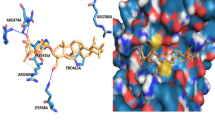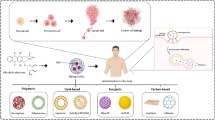Abstract
In recent years, targeted cancer therapy strategies have begun to take the place of the conventional treatments. Inhibition of the specific genes, involved in cancer progress, via small interfering RNA (siRNA) has become one of the promising therapeutic approaches for cancer therapy. However, due to rapid nuclease degradation and poor cellular uptake of siRNA, a suitable carrier for siRNA penetration inside the cells is required. We used chitosan nanoparticles (CS-NPs) to efficiently deliver ATP-binding casette E1 (ABCE1) and eukaryotic release factor 3 (eRF3)-targeting siRNAs, individually and together, to reduce the proliferation and induce the apoptosis of breast cancer cells. The CS-NPs were generated by ionic gelation method using tripolyphosphate (TPP) as a crosslinker. Nanoparticles (NPs) were obtained with diameters ranging between 110 and 230 nm and the zeta potential of approximately 27 mV optimizing the solution pH to 4.5 and CS/TPP mass ratio to 3:1. Loading efficiencies of 98.69 % ± 0.051 and 98.83 % ± 0.047 were achieved when ABCE1 siRNA and eRF3 siRNA were entrapped into the NPs, respectively. Cell proliferation assay demonstrated that siRNA-loaded CS-NPs were more effective on cancer cells when compared to siRNAs without CS-NPs. Parallel results were also obtained by apoptosis/necrosis, double-staining analysis. Within our study, the potency of ABCE1 and eRF3 siRNAs were shown for the first time with this kind of polymeric delivery system. The results also indicated that ABCE1 and eRF3, important molecules in protein synthesis, could serve as effective targets to inhibit the cancer cells.







Similar content being viewed by others
References
Agnihotri SA, Mallikarjuna NN, Aminabhavi TM (2004) Recent advances on chitosan-based micro- and nanoparticles in drug delivery. J Control Release 100(1):5–28
Amidi M, Mastrobattista E, Jiskoot W, Hennink WE (2010) Chitosan-based delivery systems for protein therapeutics and antigens. Adv Drug Deliv Rev 62(1):59–82
Brannon-Peppas L, Blanchette JO (2004) Nanoparticle and targeted systems for cancer therapy. Adv Drug Deliv Rev 56(11):1649–1659
Bumcrot D, Manoharan M, Koteliansky V, Sah DWY (2006) RNAi therapeutics: a potential new class of pharmaceutical drugs. Nat Chem Biol 2:711–719
Burikhanov R, Zhao Y, Goswami A, Qiu S, Schwarze SR, Rangnekar VM (2009) The tumor suppressor Par-4 activates an extrinsic pathway for apoptosis. Cell 138(2):377–388
Chauvin C, Salhi S, Jean-Jean O (2007) Human eukaryotic release factor 3a depletion causes cell cycle arrest at G1 phase through inhibition of the mTOR pathway. Mol Cell Biol 27(16):5619–5629
Elbashir SM, Harborth J, Lendeckel W, Yalcin A, Weber K, Tuschl T (2001) Duplexes of 21-nucleotide RNAs mediate RNA interference in cultured mammalian cells. Nature 411:494–498
Fan W, Yan W, Xu Z, Ni H (2012) Formation mechanism of monodisperse, low molecular weight chitosan nanoparticles by ionic gelation technique. Colloids Surf B 90:21–27
Fire A, Xu S, Montgomery MK, Kostas SA, Driver SE, Mello CC (1998) Potent and specific genetic interference by double-stranded RNA in Caenorhabditis elegans. Nature 391(6669):806–811
Gan Q, Wang T, Cochrane C, McCarron P (2005) Modulation of surface charge, particle size and morphological properties of chitosan–TPP nanoparticles intended for gene delivery. Colloids Surf B 44(2–3):65–73
Hannon GJ (2002) RNA interference. Nature 418(6894):244–251
Hershey JW (2010) Regulation of protein synthesis and role of eIF3 in cancer. Braz J Med Biol Res 43(10):920–930
Huang B, Gao Y, Tian D, Zheng M (2010) A small interfering ABCE1 targeting RNA inhibits the proliferation and invasiveness of small cell lung cancer. Int J Mol Med 25(5):687–693
Illum L (1998) Chitosan and its use as a pharmaceutical excipient. Pharm Res 15(9):1326–1331
Jemal A, Bray F, Center MM, Ferlay J, Ward E, Forman D (2011) Global cancer statistics. CA: Cancer J Clin 61(2):69–90
Katas H, Alpar HO (2006) Development and characterisation of chitosan nanoparticles for siRNA delivery. J Control Release 115(2):216–225
Ko JA, Park HJ, Hwang SJ, Park JB, Lee JS (2002) Preparation and characterization of chitosan microparticles intended for controlled drug delivery. Int J Pharm 249(1–2):165–174
Ko AH, Dolinger M, Rosenbaum EH (2008) Everyone’s guide to cancer therapy. Andrews Mcmeel universal company, Missouri
Koo H, Huh MS, Sun IC et al (2011) In vivo targeted delivery of nanoparticles for theranosis. Acc Chem Res 44(10):1018–1028
Leong KW, Mao HQ, Truong-Le VL et al (1998) DNA-polycation nanospheres as non-viral gene delivery vehicles. J Control Release 53(1–3):183–193
Liu X, Howard KA, Dong M (2007) The influence of polymeric properties on chitosan/siRNA nanoparticle formulation and gene silencing. Biomaterials 28(6):1280–1288
Liu Z, Jiao Y, Wang Y, Zhou C, Zhang Z (2008) Polysaccharides-based nanoparticles as drug delivery systems. Adv Drug Deliv Rev 60(15):1650–1662
Lopez-Leon T, Carvalho EL, Seijo B, Ortega-Vinuesa JL, Bastos-Gonzalez D (2005) Physicochemical characterization of chitosan nanoparticles: electrokinetic and stability behavior. J Colloid Interface Sci 283(2):344–351
Malkoc S, Ozturk F, Corekci B, Bozkurt BS, Hakki SS (2012) Real-time cell analysis of the cytotoxicity of orthodontic mini-implants on human gingival fibroblasts and mouse osteoblasts. Am J Orthod Dentofacial Orthop 141(4):419–426
Malmo J, Sorgard H, Varum KM, Strand SP (2012) Strand siRNA delivery with chitosan nanoparticles: molecular properties favoring efficient gene silencing. J Control Release 158(2):261–268
Mi FL, Sung HW, Shyu SS, Su CC, Peng CK (2003) Synthesis and characterization of biodegradable TPP/genipin co-crosslinked chitosan gel beads. Polymer 44(21):6521–6530
Moe B, Gabos S, Li XF (2013) Real-time cell-microelectronic sensing of nanoparticle-induced cytotoxic effects. Anal Chim Acta 789:83–90
Nguyen J, Szoka FC (2012) Nucleic acid delivery: the missing pieces of the puzzle? Acc Chem Res 45(7):1153–1162
Oh YK, Park TG (2009) siRNA delivery systems for cancer treatment. Adv Drug Deliv Rev 61(10):850–862
Pan T, Khare S, Ackah F et al (2013) In vitro cytotoxicity assessment based on KC(50) with real-time cell analyzer (RTCA) assay. Comput Biol Chem 47:113–120
Panniers R, Henshaw EC (1983) A GDP/GTP exchange factor essential for eukaryotic initiation factor 2 cycling in Ehrlich ascites tumor cells and its regulation by eukaryotic initiation factor 2 phosphorylation. J Biol Chem 258(13):7928–7934
Panyam J, Labhasetwar V (2003) Biodegradable nanoparticles for drug and gene delivery to cells and tissue. Adv Drug Deliv Rev 55(3):329–347
Petrocca F, Lieberman J (2011) Promise and challenge of RNA interference-based therapy for cancer. J Clin Oncol 29(6):747–754
Prabha S, Zhou WZ, Panyam J, Labhasetwar V (2002) Size-dependency of nanoparticles-mediated gene transfection: studies with fractionated nanoparticles. Int J Pharm 244(1–2):105–115
Ragelle H, Riva R, Vandermeulen G et al (2014) Chitosan nanoparticles for siRNA delivery: optimizing formulation to increase stability and efficiency. J Control Release 176:54–63
Rahman MA, Amin AR, Wang X et al (2012) Systemic delivery of siRNA nanoparticles targeting RRM2 suppresses head and neck tumor growth. J Control Release 159(3):384–392
Rajasekhar VK, Holland EC (2004) Postgenomic global analysis of translational control induced by oncogenic signaling. Oncogene 23(18):3248–3264
Ramis G, Martinez-Alarcon L, Quereda JJ et al (2013) Optimization of cytotoxicity assay by real-time, impedance-based cell analysis. Biomed Microdevices 15(6):985–995
Reitan NK, Maurstad G, de Lange Davies C, Strand SP (2009) Characterizing DNA condensation by structurally different chitosans of variable gene transfer efficacy. Biomacromolecules 10(6):1508–1515
Ren Y, Li Y, Tian D (2012) Role of the ABCE1 gene in human lung adenocarcinoma. Oncol Rep 27:965–970
Ruckert F, Samm N, Lehner AK et al (2010) Simultaneous gene silencing of Bcl-2, XIAP and Survivin re-sensitizes pancreatic cancer cells towards apoptosis. BMC Cancer 10(379):1–7
Ruddon RW (2007) Cancer biology. Oxford University Press, New York
Shu XZ, Zhu KJ (2000) A new approach to prepare tripolyphosphate/chitosan complex beads for controlled drug delivery. Int J Pharm 201(1):51–58
Shu XZ, Zhu KJ (2002) The influence of multivalent phosphate structure on the properties of ionically cross-linked chitosan films for controlled drug release. Eur J Pharm Biopharm 54(2):235–243
Shu XZ, Zhu KJ, Song W (2001) Novel pH-sensitive citrate cross-linked chitosan film for controlled drug release. Int J Pharm 212(1):19–28
Tabernero J, Shapiro GI, Lorusso PM et al (2013) First-in-humans trial of an RNA interference therapeutic targeting VEGF and KSP in cancer patients with liver involvement. Cancer Discov 3(4):406–417
Teng Z, Kuang X, Wang J, Zhang X (2013) Real-time cell analysis—a new method for dynamic, quantitative measurement of infectious viruses and antiserum neutralizing activity. J Virol Methods 193(2):364–370
Tian Y, Han X, Tian DL (2012) The biological regulation of ABCE1. Life 64(10):795–800
Turk M, Rzayev ZM, Khalilova SA (2010) Bioengineering functional copolymers. XIV. Synthesis and interaction of poly(N isopropylacrylamide-co-3,4-dihydro-2H-pyran-alt-maleic anhydride)s with SCLC cancer cells. Bioorg Med Chem 18(22):7975–7984
Weyermann J, Lochmann D, Georgens C, Zimmer A (2005) Albumin-protamine oligonucleotide-nanoparticles as a new antisense delivery system. Part 2: cellular uptake and effect. Eur J Pharm Biopharm 59(3):431–438
White-Gilbertson S, Kurtz DT, Voelkel-Johnson C (2009) The role of protein synthesis in cell cycling and cancer. Mol Oncol 3(5–6):402–408
Zheng MG, Gao Y, Huang B, Tian DL, Yang CL (2009) Suppression of ABCE1 leads to decreased cell proliferation and increased apoptosis in 95-D/NCI-H446 lung carcinoma cells. Prog Biochem Biophys 36(11):1475–1482
Zhu K, Chan W, Heymach J, Wilkinson M, McConkey DJ (2009) Control of HIF-1alpha expression by eIF2 alpha phosphorylation-mediated translational repression. Cancer Res 69(5):1836–1843
Acknowledgments
Our study was financially supported by Hacettepe University, Scientific Research Projects Coordination Unit (Grant number 011A601003).
Author information
Authors and Affiliations
Corresponding author
Rights and permissions
About this article
Cite this article
Cengiz, B.B., Asik, M.D., Kara, G. et al. Therapeutic potential of inhibiting ABCE1 and eRF3 genes via siRNA strategy using chitosan nanoparticles in breast cancer cells. J Nanopart Res 17, 168 (2015). https://doi.org/10.1007/s11051-015-2980-y
Received:
Accepted:
Published:
DOI: https://doi.org/10.1007/s11051-015-2980-y




